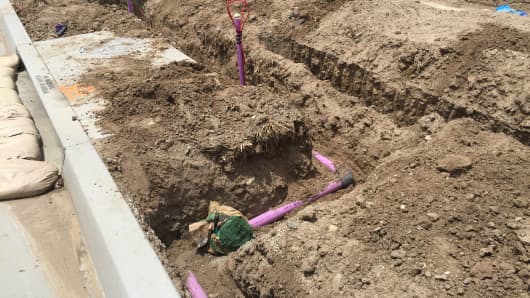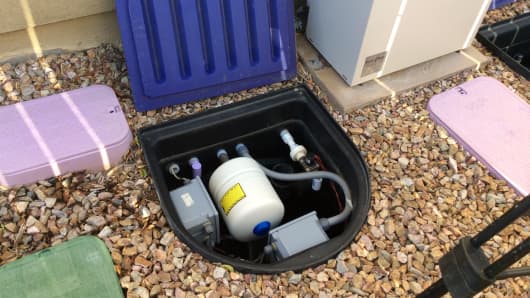Oh to have a green lawn and not feel guilty about it....
A house that thumbs its nose at the drought
by Diana Olick
Imagine a home that could recycle two-thirds of the water it uses. No need to imagine. New technology to do just that was recently approved for use in drought-parched California, and the company behind it claims it could be looking at a $15 billion business ahead.
"In five years time, every new home will have a water recycler in it," said Ralph Petroff, chairman of Nexus eWater, the Australia-based company behind the technology.
The system, which lives under two manhole-like covers on the side of the home, pulls in soapy water from the house—that is shower, dishwasher, laundry and sink water, not toilet water—and then sends it into a cleaning system. What comes out, so-called "gray water," is water that can be used for irrigation and for flushing toilets. The water cannot be used for washing or drinking.
California-based KB Home bought into the technology and just announced that it will be standard in over 50 homes in a new San Diego development. It is also demonstrating the system in model homes in Sacramento and Lancaster.
The cost is just under $10,000 per home to install, but Petroff said that price should go down as more builders buy in and the technology becomes more common. He sees it as having even more potential than solar panels.
"In five years time, every new home will have a water recycler in it," said Ralph Petroff, chairman of Nexus eWater, the Australia-based company behind the technology.
The system, which lives under two manhole-like covers on the side of the home, pulls in soapy water from the house—that is shower, dishwasher, laundry and sink water, not toilet water—and then sends it into a cleaning system. What comes out, so-called "gray water," is water that can be used for irrigation and for flushing toilets. The water cannot be used for washing or drinking.
California-based KB Home bought into the technology and just announced that it will be standard in over 50 homes in a new San Diego development. It is also demonstrating the system in model homes in Sacramento and Lancaster.
The cost is just under $10,000 per home to install, but Petroff said that price should go down as more builders buy in and the technology becomes more common. He sees it as having even more potential than solar panels.
"There is no alternative to water. That's what Californians are discovering every day," said Petroff.
In Irvine, California, developer Emile Haddad, CEO of Five Point Communities, an offshoot of Lennar, is behind the construction of thousands of new homes by various public builders. Water is not a huge problem because the Irvine water district already recycles its water through purple pipes that run through all new communities.
"Irvine has been way ahead in its thinking," said Haddad, who sees the severity of this drought as an opportunity, a tipping point, for new technology in homebuilding.
"I think what we're going to see is a much more surgical approach and we are going to put together a plan that deals with water hopefully once and forever and we're going to see in 20 years that we talk about drought as something we all can live through," he said.
In Irvine, California, developer Emile Haddad, CEO of Five Point Communities, an offshoot of Lennar, is behind the construction of thousands of new homes by various public builders. Water is not a huge problem because the Irvine water district already recycles its water through purple pipes that run through all new communities.
"Irvine has been way ahead in its thinking," said Haddad, who sees the severity of this drought as an opportunity, a tipping point, for new technology in homebuilding.
"I think what we're going to see is a much more surgical approach and we are going to put together a plan that deals with water hopefully once and forever and we're going to see in 20 years that we talk about drought as something we all can live through," he said.
At the Irvine water district, there is some skepticism about in-home gray water technology, since the area already recycles its water. That water, however, does not go out of the home and directly back into it. Recycled water is sold off for commercial real estate use, agriculture and some residential housing.
"Individual homes need to look at it community by community," said Paul Cook, general manager of the Irvine Ranch Water District, who is concerned that home water recycling in some places is as redundant as it is costly.
Read MoreUS housing starts, permits surge in April
Builders, faced with a drought with no clear end in sight, are doing all they can to make their homes as water and energy efficient as possible. Not only do they have to, but it makes them more competitive.
"Individual homes need to look at it community by community," said Paul Cook, general manager of the Irvine Ranch Water District, who is concerned that home water recycling in some places is as redundant as it is costly.
Read MoreUS housing starts, permits surge in April
Builders, faced with a drought with no clear end in sight, are doing all they can to make their homes as water and energy efficient as possible. Not only do they have to, but it makes them more competitive.
"The biggest advantage is that new homes are way more water efficient; that they are on smaller lots with very little landscaping, they can put in very drought resistant plants, and somebody concerned about their water bill would have a huge advantage buying a new home over a resale home," said John Burns, founder of John Burns Real Estate Consulting.
Burns, a resident of Irvine himself, saw his water bill go up 30 percent in the last few months and has been warned that it could go up more if he doesn't curtail usage. While new construction is more expensive, he says California buyers are more willing to pay more up front in order to save in the long run. Builders know that, and that is why prices are not coming down.
"They don't look to California for volumes, they look to California for good margins and good price appreciation," said Burns.
So far there has been no moratorium on new construction, just delays for permits, which is costly for the builders. Burns and Haddad agree that the state would take a big risk stopping new home construction, as supply is already severely limited, demand is rising and prices are soaring again.
Burns, a resident of Irvine himself, saw his water bill go up 30 percent in the last few months and has been warned that it could go up more if he doesn't curtail usage. While new construction is more expensive, he says California buyers are more willing to pay more up front in order to save in the long run. Builders know that, and that is why prices are not coming down.
"They don't look to California for volumes, they look to California for good margins and good price appreciation," said Burns.
So far there has been no moratorium on new construction, just delays for permits, which is costly for the builders. Burns and Haddad agree that the state would take a big risk stopping new home construction, as supply is already severely limited, demand is rising and prices are soaring again.



No comments:
Post a Comment